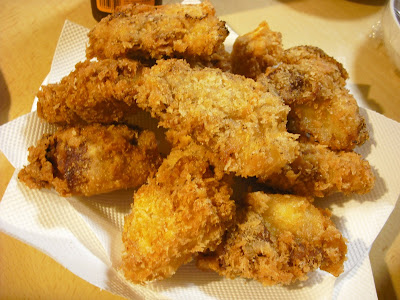Note: I made some modifications on Dec. 25.
注: 12月25日にちょっと修正しました。
The second nabemono we made in the new donabe was oden.
新しい土鍋で次に作ったのは、おでんです。
Yesterday, my daughter came home from school with these:
昨日、娘は、これを持って学校から帰ってきました:

Very small daikon that her class had grown.
娘のクラスが育ててきた、とても小さな大根です。
I decided to use the daikon, together with store-bought daikon.
その大根と店で買った大根を一緒に使うことにしました。

Thickly peel daikon, cut into 2-cm rounds, cut an x on both sides of each round, and parboil in a pot of kome no togijiru (white milky water you get when you wash uncooked rice); tap water with a small amount of uncooked rice; or tap water.
大根の皮を厚くむき、2センチ厚の輪切りにして、それぞれの両面に十字の切り込みを入れ、米のとぎ汁か、少量のお米を入れた水道水か、水道水で下茹でします。

I, for one, thinly peeled the daikon, used tap water, and parboiled for 10 min.
私は大根の皮を薄くむき、水道水を使い、10分下茹でしました。
Daikon, parboiled:
下茹でした大根:

My wife bought an assortment of oden items last week (expiration date: December 22, 2010!), together with two konnyaku and one chikuwabu.
先週、妻がおでん種のセット(賞味期限は2010年12月22日!)と、コンニャク2枚とちくわぶをひとつ買って来ました。

I used the black konnyaku only.
First, make shallow diagonal cuts at 5-mm intervals, then other shallow diagonal cuts at the same interval, vertical to the first. Do the same on the other side.
黒いこんにゃくだけ使いました。
まず、5ミリ間隔で浅い斜めの切り込みを入れ、次にそれとは垂直の浅い切り込みを同じ間隔で入れます。反対側も行います。

Then, cut into three pieces, and cut each piece diagonally to make two triangles.
次に3つに切って、それぞれを斜めに切って、2つの三角形を作ります。

Cut each triangle lengthwise in half.
三角形をそれぞれ縦半分に切ります。

You get a total of 12 triangles.
全部で三角形が12個できます。

Cut chikuwabu diagonally.
ちくわぶは斜めに切ります。

The people in Kansai (Western Japan) may not be familiar with chikuwabu. It's made from wheat flour, and is one of my favorite oden items!!
関西の人はちくわぶに馴染みがないかも知れません。小麦粉でできていて、私が好きなおでんの具の一つです!!
Parboil the konnyaku for some time.
こんにゃくをしばらく下茹でします。

I parboiled them for 1 min.
私は1分下茹でしました。
The bag contained these oden items:
袋には次のおでんの具が入ってました:

Put in a bowl, pour some hot water to get rid of excess oil, and drain.
ボールに入れ、お湯を少しかけ、余分な油を抜いて、水を切ります。

First put the following in the donabe:
Daikon, konnyaku, chikuwabu, and hard-boiled eggs.
Add dashi, soy sauce, and mirin at a ratio of 15:1:1.
(I diluted the supplied concentrate with 800 ml water, and added 300 ml water, 20 ml soy sauce, and 30 ml mirin.)
Turn on the heat, and when it almost comes to a boil, turn off the heat immediately, and put on the lid. Let it stand for at least 1 hour (half a day, if possible).
まずは次のものを土鍋に入れます:
大根、こんにゃく、ちくわぶ、ゆで卵。
出汁、醤油、みりんを15:1:1の割合で入れます。
(私は、添付の濃縮スープを800 mlの水で薄め、水を300 ml、醤油を20 ml、みりんを20 ml足しました。)
火をつけ、沸騰しそうになったら、すぐに火を消して、蓋をします。最低1時間(できれば半日)おいておきます。

20 min. before you start having the oden, add the other oden items and turn on the heat. Don't bring to a boil. Don't put on the lid.
おでんを食べ始める20分前に、他のおでんの具を入れ、火をつけます。沸騰させないでください。また、ふたをしないでください。

My first serving:
私の最初の分:

I had it with karashi (Japanese mustard).
カラシと一緒に食べました。
Tips: Don't simmer fish paste products for a long time.
Don't bring to a boil.
秘訣: 練り製品は長く煮込まない。
沸騰させない。
Edited to add on Dec. 25:
It's wrong to assume that the longer you cook, the better it tastes. Daikon, konnyaku, chikuwabu, and boiled eggs are typical ingredients that taste better (absorb flavor from the broth) when cooked longer. Fish paste products, on the other hand, taste worse (give flavor to the broth) when cooked longer.
About the broth: A dashi, soy sauce, and mirin ratio of 15:1:1 is a favorite choice of mine for oden. I tried a ratio of 20:1:1 once and found it too weak for me. Some people, however, prefer even lighter flavors; for example, 40:1:2 and 100:1:1. Another light example I found is 2000 ml : 40 ml : 50 ml : 50 ml for dashi, soy sauce, mirin, and sake, with some salt. Note also that I used dark soy sauce. Use light soy sauce if you want to make your broth light-colored.
It may be a good idea to start with a very light flavor and add more seasonings to suit your taste.
追記(12月25日):
長く煮るほど味が良くなると思うのは間違いです。大根、こんにゃく、ちくわぶ、ゆで卵は長く煮ると味が良くなる(汁から味を吸う)代表的な具材です。一方、練り製品は長く煮ると味が落ちます(汁に味を与える)。
汁について: 出汁、しょう油、みりんは15:1:1が私の好きな割合です。一度20:1:1という割合を試しましたが、薄すぎました。ところが、もっと薄味が好きな人もいます。例えば、40:1:2や100:1:1など。また、出汁、しょう油、みりん、お酒が2000 ml : 40 ml : 50 ml : 50 mlで塩少々という例も見つけました。
とても薄味から始めて、自分の舌に合うよう調味料を足すようにしてもいいかも知れません。また、私は濃口しょう油を使いましたが、汁を薄色にしたければ、薄口しょう油を使ってください。




 The reason for this is that wakame can go stale so quickly in the hot hot. Within, say, four minutes, it will no longer taste "fresh".
The reason for this is that wakame can go stale so quickly in the hot hot. Within, say, four minutes, it will no longer taste "fresh".












































